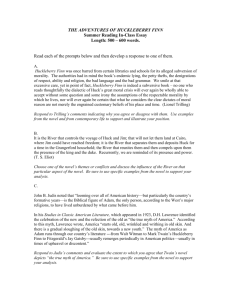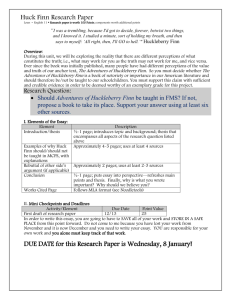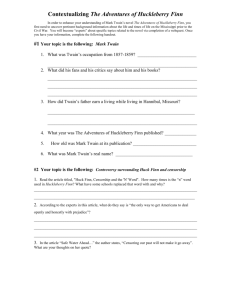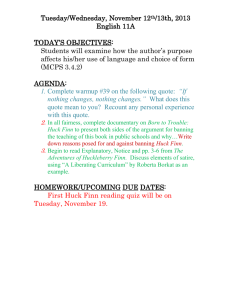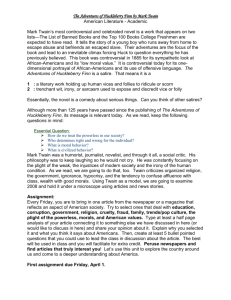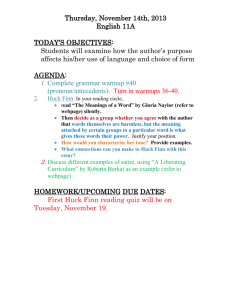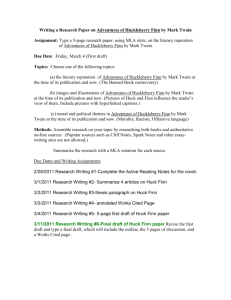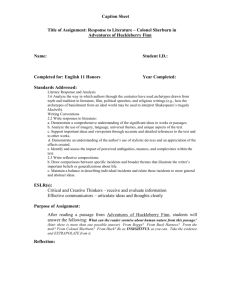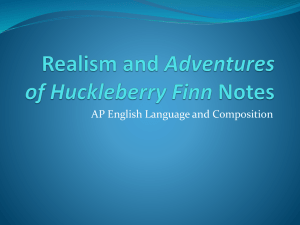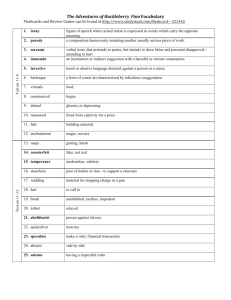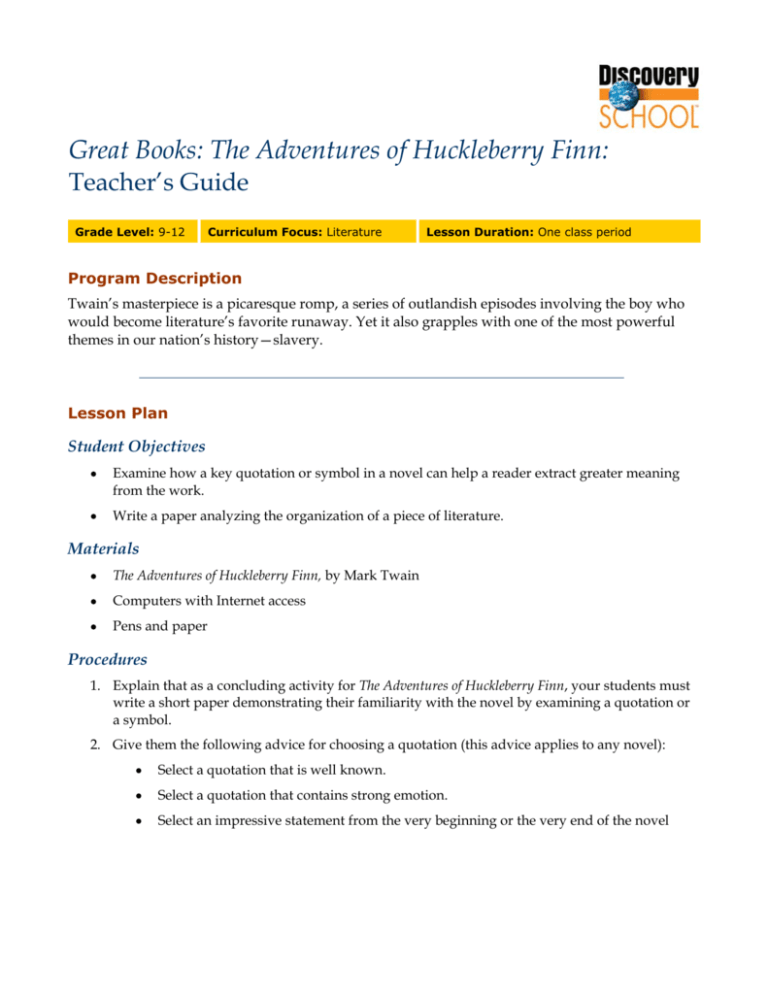
Great Books: The Adventures of Huckleberry Finn:
Teacher’s Guide
Grade Level: 9-12
Curriculum Focus: Literature
Lesson Duration: One class period
Program Description
Twain’s masterpiece is a picaresque romp, a series of outlandish episodes involving the boy who
would become literature’s favorite runaway. Yet it also grapples with one of the most powerful
themes in our nation’s history—slavery.
Lesson Plan
Student Objectives
•
Examine how a key quotation or symbol in a novel can help a reader extract greater meaning
from the work.
•
Write a paper analyzing the organization of a piece of literature.
Materials
•
The Adventures of Huckleberry Finn, by Mark Twain
•
Computers with Internet access
•
Pens and paper
Procedures
1. Explain that as a concluding activity for The Adventures of Huckleberry Finn, your students must
write a short paper demonstrating their familiarity with the novel by examining a quotation or
a symbol.
2. Give them the following advice for choosing a quotation (this advice applies to any novel):
•
Select a quotation that is well known.
•
Select a quotation that contains strong emotion.
•
Select an impressive statement from the very beginning or the very end of the novel
Great Books: The Adventures of Huckleberry Finn: Teacher’s Guide
2
As an example of a quotation that is well known and contains strong emotion, cite the following
statement by Huck in Chapter 8:
People would call me a low down Ablitionist and despise me for keeping mum—but that don’t
make no difference. I ain’t agoing to tell [that I know where Jim, the runaway slave, is], and I
ain’t agoing back there [to Jim’s owner] anyways.
As an example of a quotation that is well known and contains strong emotion, cite the following
statement by Huck in Chapter 8:
I reckon I got to light out for the Territory ahead of the rest, because Aunt Sally she’s going to
adopt me and sivilize me and I can’t stand it. I been there before.
3. Define symbol (something that stands for something larger than itself), and then guide students
in choosing a symbol (this advice applies to any novel).
•
Select a symbol that figures in the novel dramatically, an item that the novel couldn’t
exist without.
•
Select a symbol that has meaning throughout the work. For example, Huckleberry Finn
has many symbols that are essential to the story, such as the raft is a symbol for the
relationship between Huck and Jim
4. Help students verify that they have identified a meaningful quotation or symbol. Ask them to
brainstorm lists or create idea webs (which should be included in their papers) that show how
the quotation or symbol relates to the work’s themes, such as self-growth through observing life
closely and honestly or the dangers of civilization.
5. Provide this example for organizing student essays:
•
The first paragraph should include a thesis statement that identifies the quotation or the
symbol and identifies a theme in the novel.
•
The second paragraph should paraphrase the quotation or list associations with the
symbol.
•
The third paragraph should explain how the quotation or symbol appears in all parts of
the novel—beginning, middle, and end.
•
The final paragraph might explain how examining the quotation or symbol enriches a
reader’s experience.?
6. Encourage students to edit other first drafts and revise their own drafts to create a thoughtfully
written essay about The Adventures of Huckleberry Finn.
Assessment
Use the following three-point rubric to evaluate students’ work during this lesson.
•
3 points: Students clearly stated thesis statements supported by many specifics from the
novel; paragraphs were unified and coherent; contained no errors in grammar, usage, or
mechanics.
Published by Discovery Education. © 2005. All rights reserved.
Great Books: The Adventures of Huckleberry Finn: Teacher’s Guide
3
•
2 points: Students adequately stated thesis statements supported by some specifics from the
novel; paragraphs were unified and coherent; contained some errors in grammar, usage, or
mechanics.
•
1 point: Students produced unclear or absent thesis statements; paragraphs lacked unity
and coherence; contained many errors in grammar, usage, or mechanics.
Vocabulary
aversion
Definition: A strong dislike for something, with a desire to turn away from it
Context: In my schoolboy days, I had no aversion to slavery.
cynicism
Definition: The belief that all human conduct is motivated by self-interest
Context: T here always was a hint of cynicism at the far end of Twain’s comic genius.
determinism
Definition: The philosophical belief that every physical and mental event has a cause and is
never due to chance
Context: That’s what you have—a larger vision of freedom—when you really feel the forces of
determinism all around you.
dialect
Definition: A regional variety of a language, differing somewhat in pronunciation, grammar, or
vocabulary from other forms of the same language
Context: The adventure is told in the dialect of the Mississippi Valley before the Civil War.
parable
Definition: A narrative that conveys a moral lesson, used extensively in the New Testament
Context: Some see this [feud] as a parable on the youth who slaughtered one another in the Civil
War.
transformation
Definition: A distinct alteration in appearance, character, or condition
Context: The critical point of Huck’s transformation is his apology to Jim.
Academic Standards
Mid-continent Research for Education and Learning (McREL)
McREL’s Content Knowledge: A Compendium of Standards and Benchmarks for K-12 Education
addresses 14 content areas. To view the standards and benchmarks, visit link:
http://www.mcrel.org/compendium/browse.asp
Published by Discovery Education. © 2005. All rights reserved.
Great Books: The Adventures of Huckleberry Finn: Teacher’s Guide
4
This lesson plan addresses the following national standards:
•
Language Arts—Reading: Uses reading skills and strategies to understand and interpret a
variety of literary texts; Writing: Uses the general skills and strategies of the writing process,
Uses the stylistic and rhetorical aspects of writing, Uses grammatical and mechanical
conventions in written compositions, Gathers and uses information for research purposes
The National Council of Teachers of English (NCTE)
The National Council of Teachers of English (NCTE) and the International Reading Association
have developed national standards to provide guidelines for teaching the English language arts. To
view the standards online, go to http://www.ncte.org/about/over/standards/110846.htm
This lesson plan addresses the following NCTE standards:
•
The critical point of Huck’s transformation is his apology to Jim understanding of texts, of
themselves, and of the cultures of the United States and the world; to acquire new
information; to respond to the needs and demands of society and the workplace; and for
personal fulfillment. Among these texts are fiction and nonfiction, classic and contemporary
works.
•
Students read a wide range of literature from many periods in many genres to build an
understanding of the many dimensions (e.g., philosophical, ethical, aesthetic) of human
experience.
•
Students apply a wide range of strategies to comprehend, interpret, evaluate, and appreciate
texts. They draw on their prior experience, their interactions with other readers and writers,
their knowledge of word meaning and of other texts, their word identification strategies,
and their understanding of textual features (e.g., sound-letter correspondence, sentence
structure, context, graphics).
•
Students develop an understanding of and respect for diversity in language use, patterns,
and dialects across cultures, ethnic groups, geographic regions, and social roles.
•
Students participate as knowledgeable, reflective, creative, and critical members of a variety
of literacy communities.
Support Materials
Develop custom worksheets, educational puzzles, online quizzes, and more with the free teaching tools
offered on the Discoveryschool.com Web site. Create and print support materials, or save them to a
Custom Classroom account for future use. To learn more, visit
•
http://school.discovery.com/teachingtools/teachingtools.html
Published by Discovery Education. © 2005. All rights reserved.
Great Books: The Adventures of Huckleberry Finn: Teacher’s Guide
5
DVD Content
This program is available in an interactive DVD format. The following information and activities are
specific to the DVD version.
How To Use the DVD
The DVD starting screen has the following options:
Play Video—This plays the video from start to finish. There are no programmed stops, except by
using a remote control. With a computer, depending on the particular software player, a pause
button is included with the other video controls.
Video Index—Here the video is divided into four parts (see below), indicated by video thumbnail
icons. Watching all parts in sequence is similar to watching the video from start to finish. Brief
descriptions and total running times are noted for each part. To play a particular segment, press
Enter on the remote for TV playback; on a computer, click once to highlight a thumbnail and read
the accompanying text description and click again to start the video.
Curriculum Units—These are specially edited video segments pulled from different sections of the
video (see below). These nonlinear segments align with key ideas in the unit of instruction. They
include onscreen pre- and post-viewing questions, reproduced below in this Teacher’s Guide. Total
running times for these segments are noted. To play a particular segment, press Enter on the TV
remote or click once on the Curriculum Unit title on a computer.
Standards Link—Selecting this option displays a single screen that lists the national academic
standards the video addresses.
Teacher Resources—This screen gives the technical support number and Web site address.
Video Index
Part 1 (15 min.)
Discusses the enduring appeal of Huck Finn; includes background on Twain’s life and times.
Part 2 (16 min.)
Discusses life on the Mississippi and its influence on Twain’s life. Follows the adventures of Huck
and Jim.
Part 3 (12 min.)
Discusses the controversy surrounding the book. Follows Twain’s later life.
Part 4 (5 min.)
Discusses the influence of this novel on American literature, as well as an analysis of the work.
Published by Discovery Education. © 2005. All rights reserved.
Great Books: The Adventures of Huckleberry Finn: Teacher’s Guide
Curriculum Units
1. Getting To Know Samuel Langhorne Clemens (Mark Twain)
Pre-viewing question
Q: What do you already know about Mark Twain?
A: Answers will vary.
Post-viewing question
Q: How did the author feel about slavery? How were these beliefs formed?
A: He supported slavery. His family owned slaves; his community and church did not speak out
against slavery.
2. Huckleberry’s Legacy
Pre-viewing question
Q: What aspects of this book are relevant today?
A: Answers may include race relations and the struggle to make the right decisions.
Post-viewing question
Q: What comparison is made between the novel and a river?
A: The challenges and issues that come up in the novel must be navigated like the currents and
crossings in a river.
3. Classic Novel vs. Useless Trash: Debating the Value of The Adventures of Huckleberry Finn
Pre-viewing question
Q: Do you think The Adventures of Huckleberry Finn is a controversial novel? Why or why not?
A: Answers will vary.
Post-viewing question
Q: How have film versions of the novel tried to make the story non-controversial?
A: Some versions excluded Jim, changed language, had no black actors, made no jokes about
chivalry, religion, or war.
4. Meet Huck Finn
Pre-viewing question
Q: What human attributes, if any, does a huckleberry have?
A: Answers should include attributes with subtexts that connect to color, taste, etc.
Post-viewing question
Q: What qualities do you admire about Huck? Why?
A: Answers will vary.
5. Good Boy/Bad Boy: Huck Finn’s Internal Struggles
Pre-viewing question
Q: What is the difference between right and wrong? How do you know?
A: Answers will vary.
Published by Discovery Education. © 2005. All rights reserved.
6
Great Books: The Adventures of Huckleberry Finn: Teacher’s Guide
Post-viewing question
Q: Why does Huck feel sorry for the King and the Duke, even though they compromised Jim’s
safety?
A: Answers could include the fact that Huck realizes how cruel people can be to each other for no
reason, and it is just not worth it.
6. Symbolism
Pre-viewing question
Q: Why do people sometimes take advantage of each other?
A: Answers could include the competitive side of humanity.
Post-viewing question
Q: Why is the Mississippi River a geographical gate into and out of slavery?
A: The river runs through the North, which promotes freedom for African Americans, and the
South, which promotes slavery.
Published by Discovery Education. © 2005. All rights reserved.
7

